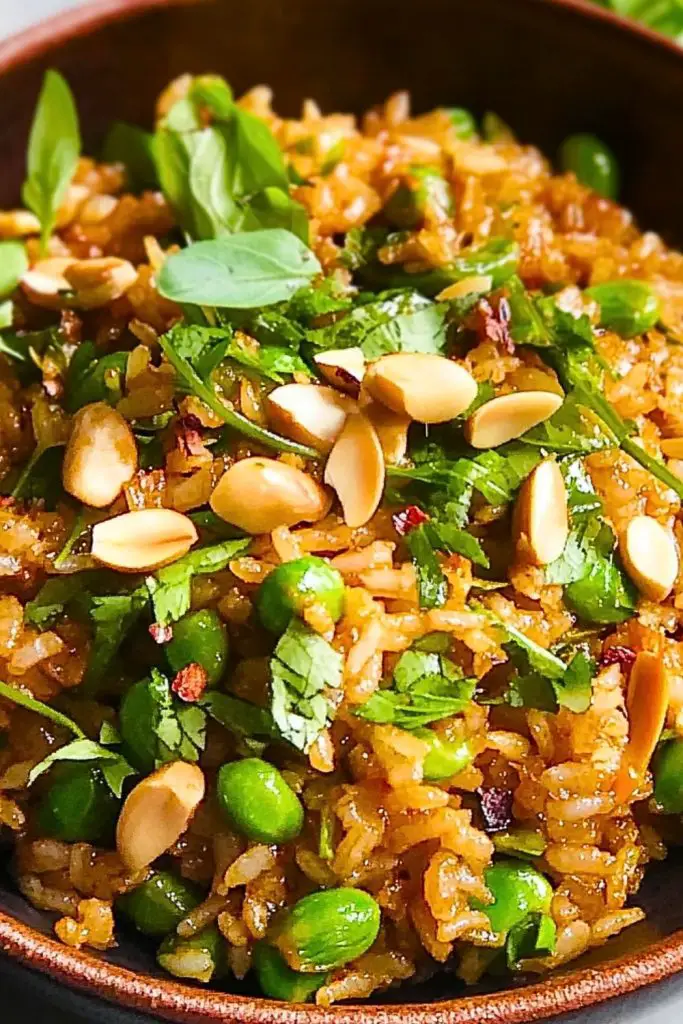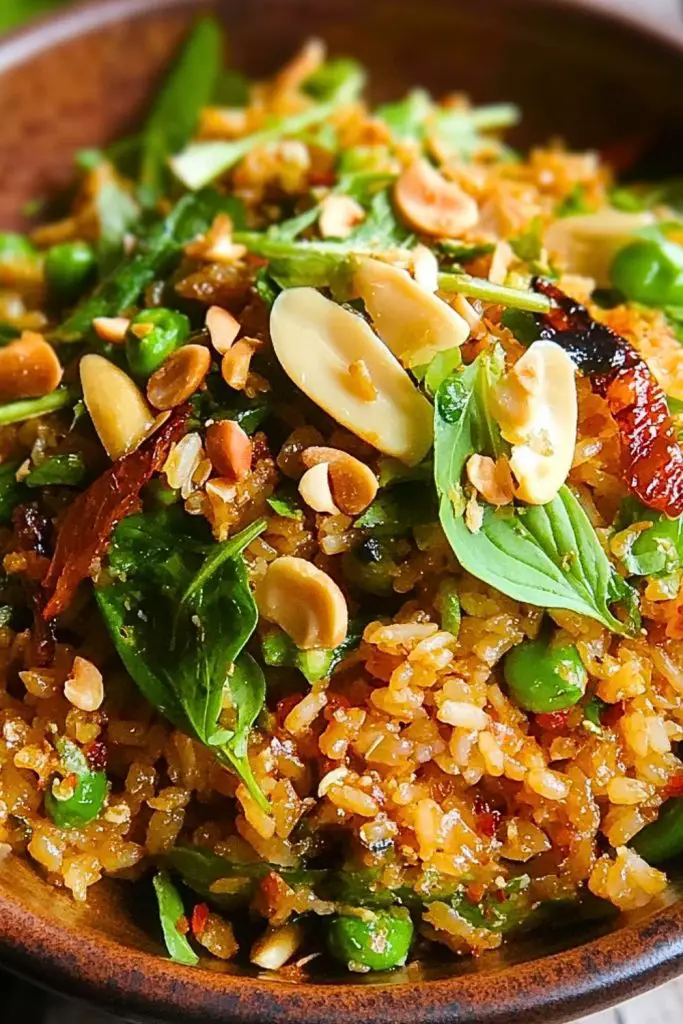There’s something uniquely satisfying about transforming leftover rice into something spectacular, and that’s exactly what I’ve done with this Satay Crispy Rice Salad. The inspiration came from my deep love for textures—crispy, nutty, fresh, and creamy all coexisting in one bite. I wanted a dish that wasn’t just delicious, but also something that could stand proud as a full meal or a standout side.

The magic of this salad lies in the contrast: golden crisp rice kissed with umami-rich satay flavors, fresh herbs like cilantro and mint to lift everything, and crunchy toppings like peanuts or almonds for that ultimate bite. It’s the kind of dish you crave again the moment the bowl’s empty. I’m excited to walk you through this vibrant recipe.
Why You’ll Love This Satay Crispy Rice Salad
This isn’t your average rice salad. It’s crunchy, savory, a little spicy, and deeply satisfying. The satay-inspired sauce infuses every grain with a nutty warmth, while the bright, raw garnishes bring refreshing contrast. It’s flexible enough for lunchboxes, beautiful enough for a dinner party, and filling enough to be a full meal on its own.
Whether you’re making it as a clever way to use up leftovers or prepping it fresh for a crowd, this recipe brings big flavor with minimal effort. Plus, it’s naturally vegetarian and easily adaptable for vegan diets.
What Kind of Rice Works Best for Satay Crispy Rice Salad?
When it comes to achieving that perfect crispy texture, not all rice is created equal. I’ve found that day-old jasmine rice or medium-grain rice works beautifully. These types hold their shape when fried and crisp up nicely without becoming too dry. Freshly cooked rice tends to be too moist, which leads to steaming instead of crisping—so if you can, use leftovers straight from the fridge.
If you only have fresh rice, spread it out on a tray and let it cool and dry out for at least an hour before cooking. This step helps you avoid clumping and ensures a golden, crunchy finish. Brown rice also works if you’re going for a nuttier flavor and want an extra fiber boost.
Options for Substitutions
One of the best things about this recipe is how forgiving and versatile it is. You can easily tweak it based on what you have on hand or your dietary preferences:
- Peanut Butter: If you’re allergic or want a different taste, try almond butter, sunflower seed butter, or tahini. Each brings a unique nutty depth.
- Vegetables: While I love adding peas and scallions, feel free to swap in shredded carrots, bell peppers, or even finely chopped broccoli.
- Nuts: Roasted peanuts give the classic satay crunch, but slivered almonds, cashews, or crispy shallots work beautifully too.
- Soy Sauce: Use tamari for a gluten-free version or coconut aminos for a soy-free alternative.
- Protein: Toss in some tofu cubes, shredded rotisserie chicken, or even crispy chickpeas for extra heartiness.
- Spice: If you like it hot, add a dash of sriracha or some finely chopped red chili into the dressing.
These substitutions don’t just make it easier to prepare—they make the dish your own. Feel free to get creative.
Ingredients for This Satay Crispy Rice Salad
Each ingredient in this dish plays a role in creating a layered, satisfying experience—texturally and flavor-wise. Here’s what you’ll need and why it matters:
- Cooked Rice (preferably day-old)
This is the heart of the dish. Chilled, slightly dry rice crisps up beautifully in the pan and carries the satay sauce without getting soggy. - Peanut Butter
The base of the satay sauce, it brings creamy richness and unmistakable nutty flavor. Smooth peanut butter melts in easily, but crunchy works if you want added texture. - Soy Sauce
Adds saltiness and umami depth to the sauce—essential for that bold, savory punch. - Rice Vinegar or Lime Juice
A splash of acidity brightens the dish and balances the richness of the peanut butter. - Honey or Maple Syrup
A touch of sweetness to round out the salty and sour elements in the dressing. - Garlic and Ginger (freshly grated)
These aromatics infuse the salad with bold, warm, and fragrant flavor. - Green Peas
They offer a pop of color, subtle sweetness, and tender texture that contrasts nicely with the crispy rice. - Scallions (green onions)
Provide freshness and a mild onion bite, ideal for brightening up the dish. - Fresh Herbs (like cilantro and mint)
These herbs bring a cool, zesty finish that lifts the overall flavor profile. - Chopped Roasted Peanuts or Almonds
Add crunch and intensify the nutty character of the salad. - Chili Flakes or Sriracha (optional)
For those who enjoy heat, this adds a lively kick without overpowering the dish.
Each ingredient layers in flavor or texture, resulting in a salad that’s far more than the sum of its parts.

Step 1: Prepare the Satay Sauce
In a small bowl, whisk together peanut butter, soy sauce, rice vinegar (or lime juice), honey (or maple syrup), freshly grated garlic, and ginger. Add a splash of warm water to loosen the sauce until it reaches a smooth, pourable consistency. Taste and adjust for salt, sweetness, or acidity. Set aside.
Step 2: Crisp the Rice
Heat a large nonstick or cast-iron skillet over medium-high heat. Add a drizzle of neutral oil (like avocado or vegetable oil), then spread your cold, cooked rice evenly in the pan. Let it sit undisturbed for a few minutes so it can develop a golden crust. Use a spatula to gently flip or stir in sections, allowing different parts to crisp up. This process takes about 6–10 minutes total.
Step 3: Add the Vegetables
Once the rice is nicely golden and crispy in spots, stir in the green peas and half of the chopped scallions. Cook for another 2–3 minutes until the peas are warmed through and the scallions begin to soften.
Step 4: Pour in the Satay Sauce
Lower the heat slightly and pour the satay sauce over the rice. Stir everything together until the rice is well-coated and the sauce is slightly absorbed. The aroma will deepen and become beautifully nutty as it hits the hot pan.
Step 5: Finish with Fresh Herbs and Toppings
Turn off the heat and immediately stir in chopped cilantro and mint. Sprinkle chopped roasted peanuts or almonds over the top, along with chili flakes or a drizzle of sriracha if desired. Garnish with the remaining scallions.
Step 6: Serve Warm or at Room Temperature
This dish is incredibly flexible—enjoy it right out of the pan while it’s warm, or let it cool and serve at room temp. It keeps its flavor and texture wonderfully for hours.
How Long to Cook the Satay Crispy Rice Salad
From start to finish, this dish comes together in about 20 minutes, especially if your rice is already cooked and chilled.
- Crisping the rice: 6–10 minutes, depending on your stove and how crispy you like it.
- Cooking vegetables and incorporating sauce: Another 5 minutes.
- Final garnishing and serving: Just a couple of minutes more.
If you’re prepping the sauce in advance, you can cut down the total time even further, making this a quick lunch or dinner option.
Tips for Perfect Satay Crispy Rice Salad
- Use cold, dry rice: This is non-negotiable for getting that beautiful crisp texture. Spread freshly cooked rice on a tray and chill for an hour if needed.
- Don’t overcrowd the pan: If making a large batch, crisp the rice in portions so it fries, not steams.
- Pre-mix the sauce: It helps coat the rice evenly without clumping. Adjust the thickness with warm water.
- Balance the sauce: Taste and tweak the satay sauce before adding it in. Every peanut butter brand varies in saltiness and sweetness.
- Layer your garnish: Save some herbs, nuts, and scallions for topping—it keeps the flavor fresh and presentation stunning.
- Use a wide skillet: This gives the rice more surface area to crisp, resulting in better texture throughout.
- Don’t rush the crisping: Let the rice sit in the pan undisturbed for a few minutes before stirring.
- Customize the spice: Add chili flakes or sriracha gradually. You can always increase the heat, but it’s harder to tone it down.
Watch Out for These Mistakes While Cooking
Even a simple dish like Satay Crispy Rice Salad can go sideways without a few key considerations. Here are the common pitfalls to avoid:
- Using freshly cooked rice: This results in mushy, steamy rice instead of crispy bites. Let it cool and dry first.
- Not heating the pan enough: Lukewarm pans won’t crisp rice. Make sure your skillet is hot before adding the rice.
- Overcrowding the skillet: Too much rice in one pan traps steam and prevents proper browning. Work in batches if needed.
- Skipping the aromatics: Garlic and ginger are essential to the satay depth—don’t leave them out.
- Adding sauce too early: Let the rice crisp before adding sauce, or it will stay soft and sticky.
- Using a sugary peanut butter without adjusting: If your peanut butter is sweetened, scale back the honey or syrup in the dressing.
- Neglecting balance: Taste the sauce before using it—adjust salt, acid, and heat to get it just right.
- Forgetting the garnish: The fresh herbs and crunch on top are what elevate this from good to unforgettable.
What to Serve With Satay Crispy Rice Salad?
While this salad can absolutely shine on its own, pairing it with the right sides or mains can make it an even more satisfying spread. Here are 8 ideas:
Stir-Fried Tofu with Chili Garlic Sauce
A flavorful, protein-packed addition that complements the nutty rice.
Chicken Satay Skewers
Double down on the satay theme with some grilled skewers on the side.
Thai-Style Cabbage Slaw
Fresh, crunchy, and slightly tangy—perfect for contrast and extra veg.
Soft-Boiled Eggs
Add creaminess and richness with jammy eggs served on top or on the side.
Coconut Soup (Tom Kha or similar)
A warm, creamy soup balances out the crispy salad with something comforting.
Pickled Vegetables
Quick pickles bring brightness and acidity, balancing the savory profile.
Roasted Sweet Potatoes
Their natural sweetness complements the earthy peanut flavor beautifully.
Lemongrass Iced Tea or Thai Iced Tea
Something refreshing to sip on that echoes the Southeast Asian flavors.
Storage Instructions
Satay Crispy Rice Salad is one of those dishes that holds up surprisingly well, even after a day or two. Here’s how to store it properly to maintain its flavor and texture:
- Refrigerator: Transfer the cooled salad to an airtight container and store in the fridge for up to 3 days. The rice may soften slightly, but the flavor deepens as it sits.
- Re-crisping Tip: If you want to revive that crispy texture, toss the chilled rice salad in a hot skillet for a few minutes before serving again. Add a tiny splash of oil if needed.
- Avoid freezing: The fresh herbs and peanut-based sauce don’t hold up well in the freezer, and the rice will become gummy upon thawing.
If you’re planning to prep this ahead for a party or lunchboxes, keep the garnishes (herbs, nuts, and scallions) separate until right before serving to maintain maximum crunch and color.
Estimated Nutrition
Please note that these values are approximate and based on a standard serving (about 1½ cups). Your specific ingredients and quantities may vary:
- Calories: 380 kcal
- Protein: 10g
- Carbohydrates: 42g
- Sugars: 6g
- Fat: 20g
- Saturated Fat: 3g
- Fiber: 4g
- Sodium: 540mg
This recipe provides a balanced combo of carbs, protein (especially with added tofu or egg), and healthy fats from the peanut butter and nuts. It’s vegetarian and can easily be made vegan and gluten-free with simple swaps.
Frequently Asked Questions
What kind of rice should I use for the crispiest result?
Use day-old cooked rice that’s been chilled in the fridge. Jasmine or medium-grain rice works best. The grains hold their shape and crisp up beautifully without clumping.
Can I make this dish vegan?
Absolutely. Just use maple syrup instead of honey in the sauce, and ensure your soy sauce or tamari is vegan-certified. The rest of the ingredients are naturally plant-based.
Is this dish gluten-free?
It can be! Simply replace regular soy sauce with tamari or coconut aminos. Always check labels to make sure your peanut butter and other condiments are gluten-free.
Can I make the rice crispy in the oven instead of on the stove?
You can, though the stovetop method gives better control. Spread the rice on a baking sheet, drizzle with oil, and bake at 400°F (200°C) for 15–20 minutes, flipping halfway through.
What can I use instead of peanut butter?
Try almond butter, cashew butter, sunflower seed butter, or even tahini. Each brings a slightly different character to the satay sauce.
How spicy is this dish?
Mild by default. You control the heat by adding chili flakes or sriracha to your liking. Leave it out completely for a no-spice version, or kick it up if you’re feeling bold.
Can I add a protein to make it a fuller meal?
Yes! Great add-ins include crispy tofu, grilled chicken, shredded rotisserie chicken, or even pan-seared shrimp. Just stir it in after the rice is crisped.
Is this good for meal prep?
Definitely. It holds up well for 2–3 days in the fridge. Just keep the fresh herbs and crunchy toppings separate and add them right before serving for the best texture.
Conclusion
Satay Crispy Rice Salad is one of those rare dishes that’s as fun to make as it is to eat. It’s bold, vibrant, and endlessly adaptable—perfect for using up leftovers while still feeling like something new and exciting. Whether you’re craving a hearty lunch, prepping ahead for the week, or entertaining friends, this salad delivers on all fronts: texture, flavor, and satisfaction.

Satay Crispy Rice Salad
- Total Time: 20 minutes
- Yield: 3-4 servings
Description
Golden, crispy rice tossed in a creamy peanut satay sauce, accented with fresh herbs, sweet peas, crunchy peanuts, and a pop of lime—this Satay Crispy Rice Salad is everything you want in a quick lunch or light dinner. It’s perfect for using up leftover rice and bursting with Southeast Asian-inspired flavors. Whether you’re looking for healthy snack ideas, easy dinner inspiration, or a meal-prep-friendly dish, this vibrant, texture-packed salad delivers a bold punch. Crispy, savory, bright, and satisfying—it’s a refreshing twist on your usual rice routine that’ll keep you coming back for more.
Ingredients
List of Ingredients
- 3 cups cooked jasmine or medium-grain rice (preferably day-old and chilled)
- 2 tablespoons peanut oil or neutral oil
- 1/2 cup frozen peas (thawed)
- 2 scallions, chopped (white and green parts separated)
- 1/4 cup chopped fresh cilantro
- 1/4 cup chopped fresh mint
- 1/4 cup roasted peanuts or almonds, chopped
- Optional: chili flakes or sriracha to taste
For the Satay Sauce:
- 3 tablespoons peanut butter
- 1 tablespoon soy sauce (or tamari for gluten-free)
- 1 tablespoon rice vinegar or lime juice
- 1 teaspoon honey or maple syrup
- 1 small garlic clove, grated
- 1 teaspoon fresh ginger, grated
- 2–3 tablespoons warm water (to thin the sauce)
Instructions
- Make the satay sauce: In a bowl, whisk together peanut butter, soy sauce, vinegar or lime juice, honey, garlic, and ginger. Add warm water slowly until the sauce is smooth and pourable.
- Crisp the rice: Heat oil in a large nonstick or cast-iron skillet over medium-high heat. Add chilled rice and press it gently into an even layer. Let cook undisturbed for 3–4 minutes, then stir and continue crisping for another 4–6 minutes until golden and crunchy in spots.
- Add veggies: Stir in the peas and white parts of the scallions. Cook for 2–3 minutes until the peas are warmed through.
- Toss with sauce: Reduce heat slightly and pour in the satay sauce. Stir well to coat the rice evenly and let cook for 1–2 minutes until heated through.
- Finish and serve: Remove from heat. Stir in chopped cilantro and mint. Top with roasted peanuts, green scallion tops, and chili flakes or sriracha if using. Serve warm or at room temperature.
- Prep Time: 10 minutes
- Cook Time: 10 minutes

